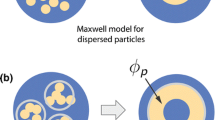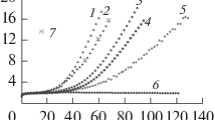Abstract
Using a statistical approach, we have estimated the size of water clusters and the number of free molecules participating in transport phenomena. The sizes of clusters and the number of molecules in them, as well as the number of free water molecules and their mean free paths, have been determined using experimental data on the temperature dependence of viscosity and density of water. It has been concluded that a temperature of 36.6°C is a special point in the range of 0–100°C. At temperatures higher than this value, the binding energy of a molecule with a cluster decreases abruptly, while the concentration of free molecules sharply increases. Quantitative data have been compared with the parameters of the superplastic state of titanium. As an example, we consider metabolism in functioning of erythrocytes of blood in an adult human.


Similar content being viewed by others
REFERENCES
P. D. Dankov and A. A. Kochetkov, Dokl. Akad. Nauk SSSR 2, 359 (1934).
G. W. Stewart and M. Roger, Phys. Rev. 30, 232 (1927). https://doi.org/10.1103/PhysRev.30.232
Ya. I. Frenkel’, Kinetic Theory of Liquids (Akad. Nauk SSSR, Leningrad, Moscow, 1945).
W. C. Röntgen, Ann. Phys. 281, 91 (1892). https://doi.org/10.1002/andp.18922810108
G. G. Malenkov, J. Struct. Chem. 47, S1 (2006).
V. I. Slesarev, Chemistry. Introduction to Chemistry of the Living World (Khimizdat, St. Petersburg, 2007).
N. P. Sargaeva and P. M. Sargaev, Izv. Ross. Gos. Pedagog. Univ. 7 (26), 112 (2007).
O. V. Mosin, Elektron. Svyaz’, No. 15, 24 (2002).
M. Yu. Tretyakov et al., Phys.-Usp. 57, 1083 (2014).
R. Moro, R. Rabinovich, C. Xia, and V. V. Kresin, Phys. Rev. Lett. 97, 123401 (2006). https://doi.org/10.1103/PhysRevLett.97.123401
V. F. Kovalenko, A. Yu. Bordyuk, and S. V. Shutov, Opt. Atmos. Okeana 24, 601 (2011).
V. V. Ivanov, V. I. Klimov, and T. M. Chernikova, J. Appl. Mech. Tech. Phys. 38, 123 (1997).
N. F. Bunkin et al., Quantum Electron. 35, 180 (2005).
G. N. Sarkisov, Phys.-Usp. 49, 809 (2006).
S. D. Zakharov and I. V. Mosyagina, Preprint No. 35 (Lebedev Phys. Inst., Russ. Acad. Sci., Moscow, 2011).
L. J. Barbour, G. W. Orr, and J. L. Atwood, Nature 393, 671 (1998). https://doi.org/10.1038/31441
S. M. Lang et al., Phys. Chem. Chem. Phys. 18, 15727 (2016). https://doi.org/10.1039/c6cp00779a
V. V. Atrazhev et al., J. Electrochem. Soc. 164, F1265 (2017). https://doi.org/10.1149/2.0041713jes
V. V. Chaban, Phys. Chem. Chem. Phys. 20, 23754 (2018). https://doi.org/10.1039/c8cp04012e
A. Verdaguer et al., Chem. Rev. 106, 1478 (2006). https://doi.org/10.1021/cr040376l
J. Liu et al., Chem. Sci. 9, 2065 (2018). https://doi.org/10.1039/C7SC04205A
O. D. Khvol’son, Physics Course (Gos. Tekhniko-teoreticheskoe Izd., Moscow, Leningrad, 1933).
J. B. Hasted, Physics of Atomic Collisions (Butterworths, 1964).
A. V. Polyanskaya and A. M. Polyanskii, in Proc. I Russ. Conf. “Physics for Life Sciences,” St. Petersburg, Russia, 2016, p. 91.
I. S. Grigor’ev and E. Z. Meilekhov, Physical Quantities. Handbook (Energoatomizdat, Moscow, 1991).
A. Murzinova, G. A. Salishchev, and D. D. Afonichev, Phys. Met. Metallogr. 104, 195 (2007).
B. A. Kolachev et al., Tekhnol. Legk. Splavov, No. 3, 10 (2007).
A. M. Polyanskiy et al., Acta Mech. 229, 4863 (2018). https://doi.org/10.1007/s00707-018-2262-8
A. A. Bogdanov, A. M. Polyanskii, and A. Ya. Fikh, in Proc. IX Int. Conf. “Modern Practical Physics,” Volgograd, Russia, 2006, p. 134.
A. V. Eletskii, V. Yu. Zitserman, and G. A. Kobzev, in Proc. XÕVII Int. Sci.-Pract. Conf. “Technical Sciences: From Theory to Practice,” Novosibirsk, Russia, 2013, pp. 105–112.
K. Murata et al., Nature 407, 599 (2000). https://doi.org/10.1038/35036519
Funding
This research was supported by program no. 31 of the Presidium of the Russian Academy of Sciences.
Author information
Authors and Affiliations
Corresponding author
Additional information
Translated by N. Wadhwa
Rights and permissions
About this article
Cite this article
Polyanskaya, A.V., Polyanskii, A.M. & Polyanskii, V.A. Relationship between Transport Phenomena and Characteristics of the Cluster Structure. Tech. Phys. 64, 902–908 (2019). https://doi.org/10.1134/S106378421906015X
Received:
Revised:
Accepted:
Published:
Issue Date:
DOI: https://doi.org/10.1134/S106378421906015X




